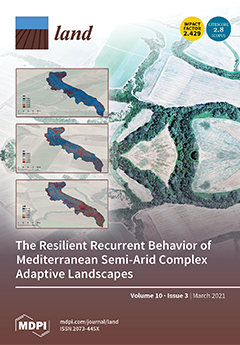Resources
Displaying 536 - 540 of 2258Application of Drone and WorldView-4 Satellite Data in Mapping and Monitoring Grazing Land Cover and Pasture Quality: Pre- and Post-Flooding
Frequent flooding worldwide, especially in grazing environments, requires mapping and monitoring grazing land cover and pasture quality to support land management. Although drones, satellite, and machine learning technologies can be used to map land cover and pasture quality, there have been limited applications in grazing land environments, especially monitoring land cover change and pasture quality pre- and post-flood events. The use of high spatial resolution drone and satellite data such as WorldView-4 can provide effective mapping and monitoring in grazing land environments.
Evaluation of Ecological Environment Effect of Villages Land Use and Cover Change: A Case Study of Some Villages in Yudian Town, Guangshui City, Hubei Province
Rapid economic development has a significant negative impact on the rural ecological environment. Evaluating the ecological environmental effect of land use and its change trend at the village scale has important practical significance for maintaining ecological functions and ensuring ecological safety. Taking a typical village in Yudian Town as an example, we applied a land-use ecological environment effect evaluation and the CA-Markov change trend prediction model and constructed an index of ecological environmental effect status.
Land Tenure Security and Health Nexus: A Conceptual Framework for Navigating the Connections between Land Tenure Security and Health
The rise of urban populations has rendered cities in both developed and developing countries vulnerable to poor health and diseases that are associated with urban living conditions and environments. Therefore, there is a growing consensus that while personal factors are critical in determining health, the urban environment exacerbates or mitigates health outcomes, and as such the solution for improving health outcomes in urban settings can be found in addressing socio-environmental factors that shape urban environments.
Evaluation of the Effect of Stability Schemes on the Simulation of Land Surface Processes at a Western Tibetan Site
The surface fluxes calculated in land surface models (LSMs) are sensitive to the determination of the stability parameter. Further, calculation of the surface fluxes over the Tibetan Plateau (TP) is crucial in the simulation of regional and global weather and climate. In this study, we use 2-year micrometeorological data measured from Shiquanhe, located in the western TP, to evaluate the performance of the widely used Noah LSM with five stability parameterization schemes.
Fully Portraying Patch Area Scaling with Resolution: An Analytics and Descriptive Statistics-Combined Approach
Scale effects are inherent in spatial analysis. Quantitative knowledge about them is necessary for properly interpreting and scaling analysis results. The objective of this study was to systematically model patch area scaling and the associated uncertainty. A hybrid approach was taken to tackle the difficulty involved. Recognizing that patch’s size and shape play the key role in shaping its scaling behavior, a function model of patch area scaling based on patch morphology was first conceptually formulated.



